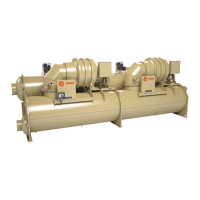82
CDHH-SVX003C-EN
RuptureGuard
Operation
The rupture disk monitors the pressure inside the chiller. If
the pressure exceeds the disk’s burst setting, the disk
ruptures, allowing the chiller pressure to enter the valve
holder compartment upstream of the relief valve. If the
pressure is above the pressure setting of the relief valve,
the valve will open, allowing only the amount of refrigerant
to escape to keep the pressure within safe operating limits.
The excess flow valve maintains the downstream side of
the rupture disk at atmospheric pressure to assure proper
operating conditions for the disk. When the disk bursts, the
rapid pressure increase causes the excess flow valve to
seal and the valve holder area becomes pressurized.
A disk rupture will be indicated by a pressure reading on
the gauge and the pressure switch contacts will close. The
pressure switch is an optional accessory and does not wire
to the control panel. The pressure switch can be connected
to a customer-supplied building automation system (BAS).
EarthWise Purge
General Information
Centrifugal chillers that use low-pressure refrigerants, such
as R-1233zd, operate with areas of the chiller at less than
atmospheric pressure. Non-condensables in the air, such
as water and nitrogen vapor, may leak into these low-
pressure areas and accumulate in the condenser. If these
non-condensables are not removed, the condenser loses
its ability to condense refrigerant efficiently and the
pressure of the condenser increases. Increased condenser
pressure lowers the chiller’s efficiency and capacity.
A purge system is required on low-pressure centrifugal
chillers. It is a device that is externally mounted on the
chiller. Its purpose is to remove non-condensable materials
that have leaked into the machine.
Note: For convenience, the term “air” is often used in
describing non-condensables removed by the purge
system, although any other non-condensable
materials that may exist in the chiller are also
removed by the purge system.
How a Purge System Works
From a functional standpoint, the purge system can be
divided into subsystems of components. This section
identifies and describes the function of these subsystems.
Refrigeration Circuit Subsystem
The purge evaporator of the refrigeration circuit is located
in the purge tank. The purge tank is connected to the chiller
condenser by supply and return lines through which chiller
refrigerant can freely flow.
The purge evaporator coil presents a cold condensing
surface to the chiller refrigerant entering the purge tank.
When the purge refrigeration system is running, refrigerant
from the chiller condenser is attracted to the cold surface of
the purge evaporator. When the gaseous refrigerant
contacts the surface of the purge evaporator coil, it
condenses into a liquid, leaving a partial vacuum behind.
More refrigerant vapor from the chiller condenser migrates
to the purge tank to fill the vacuum.
The liquid refrigerant that has condensed in the purge tank
returns to the chiller condenser through the liquid return
line. The return line includes a filter-drier and a moisture-
indicating sight glass.
The condensing unit is air-cooled and is operable whether
the chiller is running or not. No additional cooling source is
required.
Operating Principles

